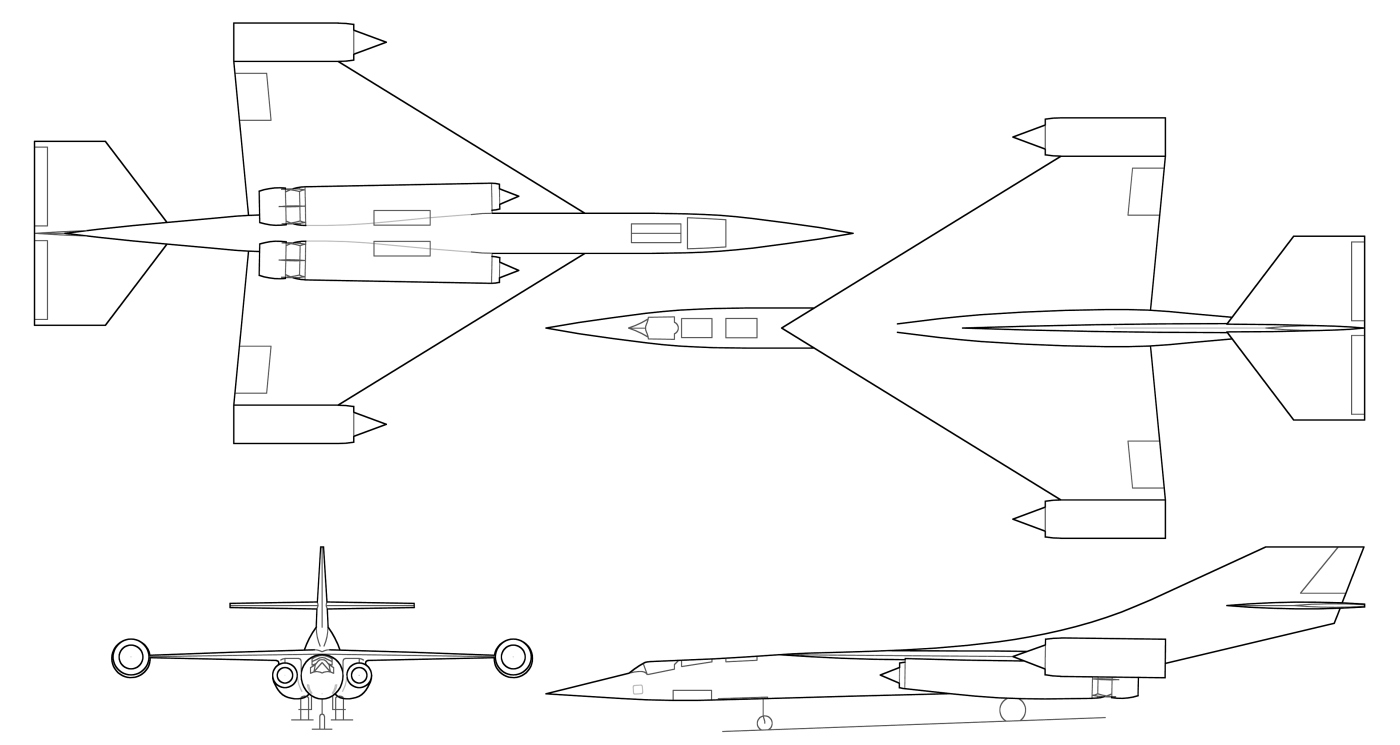Recently arrived in my mailbox was Paul Suhler’s new book, “From RAINBOW to GUSTO: Stealth and the Design of the Lockheed Blackbird.” There have been over the years a great many books on the SR-71 and its development, but this is the first to make a serious stab at a comprehensive history of the designs leading up to the final A-12 “Blackbird” design.
This book describes advanced, semi-stealthy derivatives of the U-2, including the “GUSTO Mark 2,” which used a twin-boom design and relocated the inlet to the top of the fuselage; the Navy’s Project CHAMPION “Ramjet Kite” designs which included a large subsonic tow plane hauling what certainly look like vast inflatable-wing kites with giant ramjet engines; and moves on to describe the Archangel series of supersonic designs produced by Kelly Johnson’s team at the Skunk Works, as well as the FISH and Kingfish competitors designed by Convair. And this time, rather than a simple text description of these interesting designs, “RAINBOW to GUSTO” actually provides three-view drawings of the great majority of them. A quick count shows about 42 layout drawings… including one of the D-33 design, a manned A-12 follow-on vehicle meant for takeoff from small runways (including aircraft carriers), featuring a Concorde-like planform and an RL-10 booster rocket. There are also never-before-published photos of the desk models of FISH and of several Kingfish variants.
More than just a series of design studies, the book is also the story of the people involved and is based on interviews with stealth researchers and aircraft designers and on hundreds of declassified documents. It has the first public telling of why Convair was brought in to compete with Lockheed, why the B-58B was cancelled by the Air Force, who discovered the flying saucer shape, and why Lockheed didn’t build it.
While I have not yet completely read the book (man, I’m slow), it is a great little book. And that is the one complaint I have about it: it has a relatively small format, 9 by 6 inches. As a result of this, the layout drawings are necessarily reproduced very small. However, I have contacted the author, and we have worked out something of a fix for this: I will be showing many of the drawings from the book here on this very blog, at much higher rez than in the book. But if you want to know the details of the design – history, context, performance, etc. – well, you’ll just have to buy the book. Something I heartily recommend that you do.
Due to Lockheed copyright restrictions, the original drawings cannot be reproduced except within the pages of Mr. Suhler’s book. However, I’ve gotten the go-ahead to re-draw them. The first drawing out the hatch is the Archagel 1 (A-1), figure 46, page 98. This particular drawing has a Source Grade of four: ![]()

I will be creating these drawings at a leisurely pace… one every day or three. Combine these drawings and “RAINBOW to GUSTO,” and you will have a wonderful history of the SR-71 development, just the thing for project-heads!
“RAINBOW to GUSTO” is available from Amazon.com (for $39.95) and direct from the AIAA ($29.95 for AIAA members).
———-
UPDATE: To download the high-rez version of the A-1 drawing, simply click THIS LINK. You will be prompted for a username and a password. For the A-1 drawing, use these:
Username: the first word in the body of the text on page 98
Password: the first word in the body of the text on page 99
The high-rez drawings will include further information. Data that’s on the drawings but not in the text of the book – dimensions, wing area, etc. – will be included on the drawings. But the only way to get the high-rez drawings is… to get a copy of the book.
3 Responses to ““From RAINBOW to GUSTO:” Archangel A-1”
Sorry, the comment form is closed at this time.
…Hmmm. I see a *lot* of SUNTAN in that design.
I have the book and was disappointed with the quality of the drawings and pics. I am very pleased that you have chosen to undertake this task. I think you should be paid for the effort. Do you intend to sell these? If so, count me as a customer. If not, I’d like to contribute somehow.
NOTE: the image quality was a source of annoyance for the author as well. He’d tried to get better reproduction, but the size limitation of the book… well, there it is.
> I think you should be paid for the effort.
I think I should be paid for a *lot* of things. Oh, well…
> Do you intend to sell these?
Nope. Low-rez images will be made freely available to anyone reading the blog… and I’ve just confirmed a way to make high-rez images freely available to readers of the blog who happen to have a copy of the book right in front of them. Check back later today sometime to see an UPDATE to the posting.
> I’d like to contribute somehow.
Well, there’s always the “Donate” button you should see on the right side of the screen…
I’m doing this because I want to see the Archangel (and other relevant) designs shown clearly and accurately… and this looked like my one shot at makign it happen. There were a number of issues that stood in the way of presented the actual drawings, which would have been my preference, but all-new drawings with Source Grading seems a reasonable compromise.
And while I’d love to do an A-Series article for APR (something I’ve considered for a long while, but never really had enough info to make worthwhile), I’m not going to do so for a *long* time now – if ever – as it would conflict with Suhler’s book. Since Paul Suhler was kind enough to provide me with good scans of the drawings, I’m not going to compete with his work.